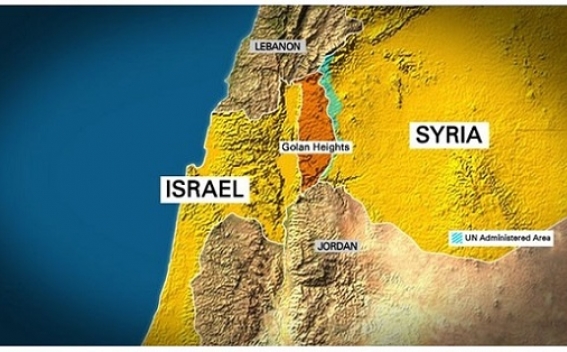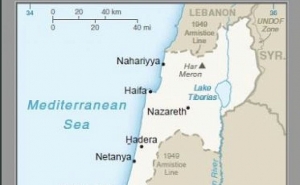Tracing the History of Golan Heights (INFO)

On March 25, 2019 US president Donald Trump signed a declaration recognizing Israeli sovereignty over Golan Heights, which caused unrest among the international community. What is the history behind the Golan Heights issue?
The Golan Heights is a basaltic plateau in the Levant, spanning about 1,800 square kilometers, 1200 meters above the sea level, south-east of Syria. It is bordered by the Yarmouk River in the south, the Sea of Galilee and Hula Valley in the west, the Anti-Lebanon with Mount Hermon in the north and Wadi Raqqad in the east.
Israel occupied the Golan in 1967 as a result of the Arab-Israeli six-day war. The war and the Israeli occupation resulted in over 100,000 Syrians leaving the Golan Heights. Later the Israeli authorities did not allow Syrians to return their homes out of security considerations. After the war there remained 7,000 Syrians in Golan, those being mainly Druze in 4 villages. During the 1973 Arab-Israeli war Syria’s attempts to return the Heights failed (Israel occupies 70% of the Golan Heights).
In 1974 Syria and Israel signed US facilitated Agreement on Disengagement, which recognized the Golan Heights as a buffer zone under the UN with the UN peacekeeping forces deployed there (they had to leave in 2014 during the Syrian conflict due to frequent clashes with the Islamists). Later in 1975, according to the agreement Israel returned the city of Quneitra to Syria (5% of the occupied territory), another buffer zone.
In 1981 the Israeli Knesset adopted a law to annex Golan which in fact meant occupation of Syrian territory. This decision was cracked down on by the international community. The UN security Council adopted resolution 497 calling on Israel to rescind its action. However Israel did not fulfill the claims of the international community.
In 1999-2000 during Syria-Israel talks under the auspices of the US, Israel was recommended to return Golan to Syria with the end of establishing diplomatic relationships. The talks, however, were not a success. It is to be noted that since the 1973 war Syria has never tried to return Golan through military operations.
Following the occupation, Israel set to integrate Golan into the Jewish state both demographically and economically. It is to be noted that the Golan Heights are of strategic significance both security and economy wise. Golan is rich in water resources, something that boosts its value in the region with scarce water resources.
The Heights nowadays is considered as one of the most prosperous Israeli regions with close to zero unemployment rate. 50% of the Israeli mineral water production, a quarter of winery and 40% of wine export account for Golan. Moderate weather conditions and an area replete with historical and cultural monuments makes it a haunt for huge numbers of tourists. Annually 2,1 tourists visit Golan. And the Palestinian-Israeli conflict escalations do not as a rule decrease the number of tourists.
As of 2010, 20,000 Israelis inhabited 32 Jewish regions in Golan. The Druze people inhabiting Golan mainly preserve their Syrian citizenship.
-
 17:08
17:08The regular session of the Anti-corruption Policy Council takes place in Jermuk
-
 15:05
15:05The Prime Minister sends congratulatory messages to the supreme leader of Iran and the President of Iran
-
 11:11
11:11Armenia sends earthquake aid to Turkey
-
 10:43
10:43Commemoration of the Pontiff St. Sahak Partev
-
 09:16
09:16Some roads are closed and difficult to pass in Armenia
-
 19:55
19:55Phone conversation of the Foreign Minister of Armenia with the U.S. Assistant Secretary of State for European and Eurasian Affairs
-
 18:30
18:30Prime Minister Pashinyan and President Khachaturyan meet
-
 18:20
18:20Ararat Mirzoyan with Co-Chairman of the OSCE Minsk Group of France Brice Roquefeuil
-
 17:01
17:01Humans could land on Mars within 10 years, Musk predicts
-
 16:45
16:45France, US urge 'immediate' end to Nagorno Karabakh blockade
-
 16:01
16:01Blockaded Nagorno Karabakh launches fundraiser to support quake-hit Syria
-
 15:59
15:59Earthquake death toll in Turkey rises to 18,342
-
 15:43
15:43Ararat Mirzoyan Held a Telephone Conversation with Sergey Lavrov
-
 15:06
15:06French president rules out fighter jet supplies to Ukraine in near future
-
 14:47
14:475 Day Weather Forecast in Armenia
-
 14:44
14:44President Vahagn Khachaturyan wrote a note in the book of condolences opened in the Embassy of Syria in Armenia
-
 14:20
14:20Azerbaijan’s provocations impede establishment of peace and stability – Armenian FM tells Russian Co-Chair of OSCE MG
-
 12:57
12:57France representation to OSCE: Paris calls on Azerbaijan to restore freedom of movement through Lachin corridor
-
 11:40
11:40Command of Kosovo forces highly appreciated preparation of Armenian peacekeepers
-
 10:16
10:16The United States withdrew from sanctions against Syria for six months the provision of assistance after the earthquake
day
week
month
Humidity: %
Wind: km/h








